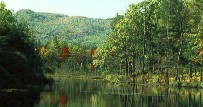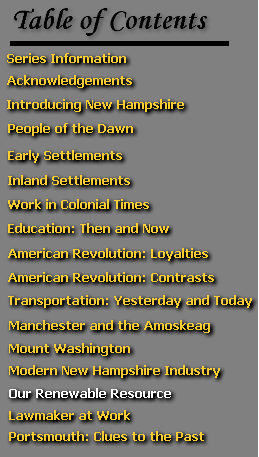SUMMARY
 This
lesson examines the forests of New Hampshire, past and present. Forests
are an important part of New Hampshire's way of life. Close to 85% of our
state's 5.7 million acres is forested. Over 16,000 New Hampshire citizens
work in the forest industry and the forest industry contributes $1.7 billion
to the state's economy.Life in New Hampshire would be very different without
our forests, which give us many important products, and provide us with
shade, rest, recreation and beauty. They also play a key role in nature's
ecological cycle. This
lesson examines the forests of New Hampshire, past and present. Forests
are an important part of New Hampshire's way of life. Close to 85% of our
state's 5.7 million acres is forested. Over 16,000 New Hampshire citizens
work in the forest industry and the forest industry contributes $1.7 billion
to the state's economy.Life in New Hampshire would be very different without
our forests, which give us many important products, and provide us with
shade, rest, recreation and beauty. They also play a key role in nature's
ecological cycle.
New Hampshire's forests have
played a major part in the state's history. The first job of the early
settlers of New Hampshire (1620s) was to clear some of the forest to plant
and raise the food crops that would keep them alive. The real beginning
of New Hampshire's logging industry was in 1634. That was the year the
first shipment of tall pines arrived in England to be made into masts for
the ships of the Kinq's Navy. The tall pine trade with England ended with
the American Revolution, but the forests of New Hampshire continued to
be cleared for farmland right up through the 1840s and 1850s. By then,
about 70% of the land south of the White Mountains had been cleared. Many
New Hampshire farms were abandoned as the settlers moved in the 1850s to
the richer farmlands of the Midwest.
In the late 1880s, logging
became a major industry in New Hampshire, especially in the hardwood forests
of the North Country. This was the North Country's greatest, most intense
logging era. The careless harvesting methods of the late 1880s set the
stage for terrible fires that raged annually through North Country forests.
Several things changed this
picture of wasted forests and uncontrolled fires. Laws were passed to protect
the great forests and establish the U.S. National Forest Service. Silas
Weeks, a senator from New Hampshire, was one of the leaders in this effort.
The Great Depression of the 1930s brought most business and industry to
a standstill. This gave New Hampshire's forests a chance to recover. Third,
the people in the logging industry in New Hampshire today know how vital
it is to manage the woodlands carefully. These people have the knowledge,
skills and equipment to do the job well. There are many steps in the proper
harvesting of New Hampshire's woodlands, ranging from the choice of trees
to be cut to the separation of the tree into its various products.
In addition to the basic
products of the logging industry, lumber and paper, New Hampshire forests
produce more than 50 kinds of wood products: crates, coat hangers, kitchen
cabinets, and many other things. Our forests of today are not an endless
resource, as was once believed, but they are a renewable resource .
OBJECTIVES
1. To examine the
forests of New Hampshire historically and in the present.
2. To further students'
awareness of the importance of forests in New Hampshire's way of life.
3. To increase knowledge
about the products obtained from our logging industry.
4. To further understanding
of today's logging industry.
5. To increase students'
understanding of the nature of our forests--a renewable, but not an endless
resource.
PRE-VIEWING ACTIVITIES
1. Discuss the ways
in which people earn their livings in the students' communities. List those
jobs which provide employment because of our forests.
2. Define the term
"way of life." Describe how our way of life in New Hampshire is affected
by our forests.
3. Ask students to
list five uses for wood--a basic material obtained from the trees in our
forests.
4. Examine your own
classroom, listing all the products made from wood.
5. Discuss the class's
interactions and experiences with New Hampshire's forests.
POST-VIEWING ACTIVITIES
1. Pretend that you
are living in colonial times. Describe your dependence on wood.
2. Research the history
of logging in New Hampshire.
3. You are an agent
of the English king during the time period 1634-1775. Write a mandate concerning
the tall pines of New Hampshire. Present your restrictions to the class.
4. Pretend that you
are a lumberjack living in the 1880s. Describe your feelings about invading
the forests of New Hampshire. Why were you concerned with "letting the
daylight into the wood?" Was your philosophy "cut and get out?" Explain
your position.
5. Explain what might
happen if a lumberjack of the 1880s and a logger of today might meet. What
would their views be on the forests of New Hampshire?
6. Look into and report
on the early beginnings of the U.S. National
Forest Service.
7. Write a composition
describing life in New Hampshire without our forests.
8. Tour a paper mill.
9. Describe a law
you would like to see in effect regarding the forests of New Hampshire.
Check to see if, in fact, such a law exists. Who would benefit from your
law? Would your law insure that the forests of New Hampshire would remain
our "renewable resource?"
10. Invite a person
from the logging industry to speak to the class on current methods of operation.
11. Write to the Society
for the Protection of New Hampshire Forests in Concord, asking about
the goals and objectives of the organization.
12. Write to your
local chapter of the New Hampshire Timberland
Owners Association, asking for information on this organization.
13. Invite your regional
forest agent from Cooperative Extension Service to speak.
14. Write to the White
Mountain National Forest Service for information on forestlands.
15. Write a newspaper
headline and article describing the woodlands and forests of New Hampshire
in the year 2020.
VOCABULARY
-
renewable
-
logging
-
ecological cycle
-
skidder
-
resource
-
chipper
-
King's Trees
-
debank
-
fireswept
-
loader
-
pulpwood
-
mast
PEOPLE TO KNOW
-
Silas Weeks
-
lumberjack
-
King's Agent
-
chopper
-
colonist
-
shipbuilder
-
lumber baron
IMPORTANT DATES
| 1620s |
First settlers landed in
New Hampshire; 90% of land covered with trees. |
| 1634 |
Beginning of New Hampshire's
logging industry--the shipment of tall pines to England to be made into
masts for the King's Navy. |
| 1840-50 |
Forests of New Hampshire
cleared for farmiand; about 70% of land south of the White Mountains had
been cleared. |
| 1850s |
Movement of settlers west.
New forests of white pine grew on the many abandoned farms of New Hampshire. |
| 1880s |
Logging became a major industry
in New Hampshire, especially in the hardwood forests of the North Country.
This time was the North Country's greatest and most intense logging era. |
| 1930s
|
The creation of the White
Mountains National Forest. The Great Depression brought most business and
industry to a standstill, gave New Hampshire's forests a chance to recover
from prior treatment. |
| Present |
Individuals in the logging
industry concerned with the proper and careful management of New Hampshire's
woodlands. |
WEB RESOURCES
|




